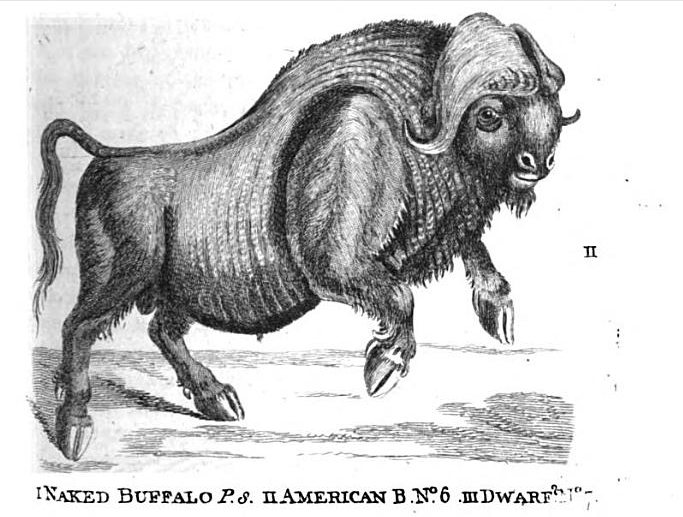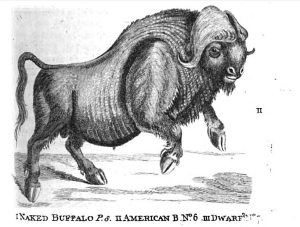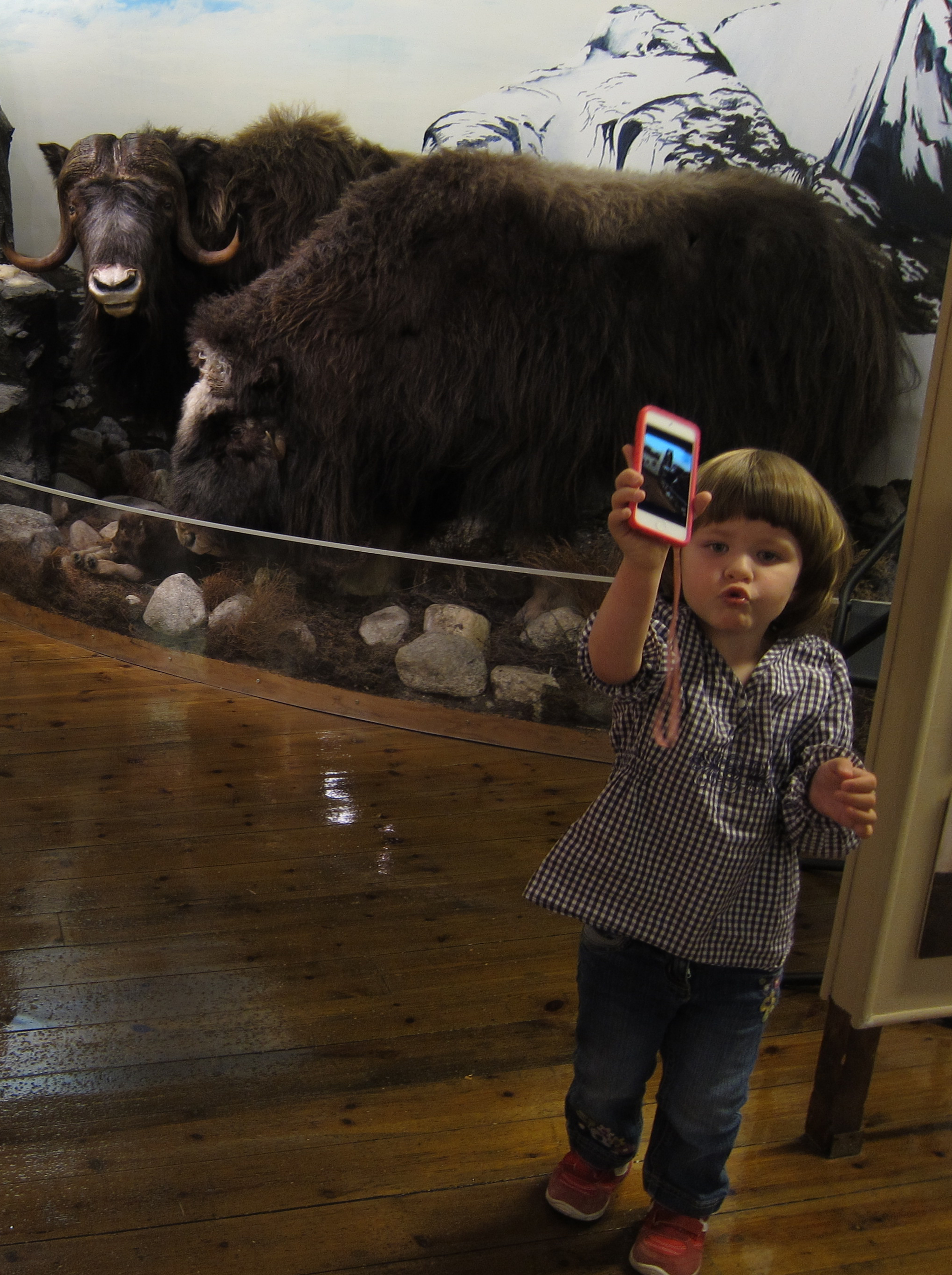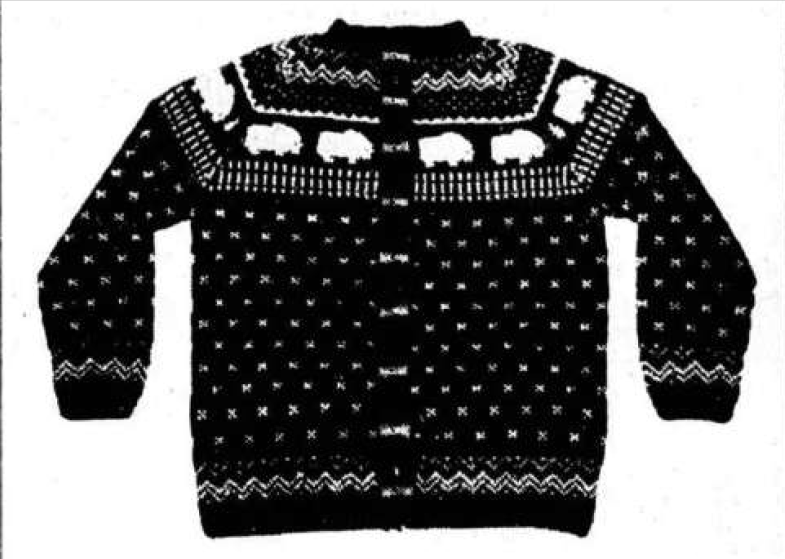
Worst named animal on the planet
In my 2013 talk about Migrant Muskox, I mentioned the problem with the muskox’s name: “The muskox (Ovibos moschatus) that I’m talking about today is probably the worst named animal on the planet: it has neither musk nor is it an ox.” So what gives?
The first written description of the muskox was published in 1744. Pierre François Xavier de Charlevoix, a French Jesuit and historian, published a description of “New France” (i.e. North America) called Histoire et description generale de la Nouvelle France (which is available online). On page 132, he describes an animal encountered in the area of Hudson Bay with long, beautiful hair and a musky smell in rutting season — and he gave it the name boeuf musqué. Musk was originally a label for the odour from the gland of a male musk deer, a native of Asia, which was used in perfumes, but animals with similar type odours were given musk names, like the muskrat and musk shrew.

There was in the late 18th century quite a bit of confusion about whether the “American buffalo” (or bison) was the same animal. Thomas Pennant’s drawing of an American bison in Synopsis of Quadrapeds (1771) is pretty funny with a plains bison body topped by muskox horns. But they soon figured out that it was a separate species.
Charlevoix’s original descriptor for the animal stuck. It became muskox in English, moskusokse in Norwegian, myskoxe in Swedish, Moschusochse in German, and stayed boeuf musqué in French. The first scientific name of the animal was Bos moschatus — an exact translation of boeuf musqué — given by George Zimmerman in 1780. In 1816, Blainville placed the muskox taxonomically into its own genus, Ovibus, which represents it as an intermediate between sheep (Ovis) and oxen (Bos), but retained the musk part as moschatus. From a scientific naming standpoint, credit to Blainville for this decision seems to have been forgotten in the scientific literature: everyone nowadays calls the species Ovibos moschatus Zimmerman (1780) and the most recent mention of Blainville 1816 I can find is in Ontogenetic and Other Variations in Muskoxen published in 1913. Scientific credit comes and goes.
The “muskox” name posed problems at times for those seeking to domesticate and acclimate the animal — because, well, it gave muskox a bad name. Vilhjalmur Stefansson noted in The Northward Course of Empire (1922) that the meat of muskox was quite similar to beef and would be a success
if only the name can be changed into something more attractive. … Although musk was a delicate and expensive perfume as recently as the time of our grandmothers, the fashion has so changed since then that the odor is now known by name only and the impression has begun to spread that it is a stink rather than a perfume. … Our first problem in domesticating the musk ox is, accordingly, choosing for the beast a new name. (p.139)
Stefansson decided that ovibos would make the most sense since it was the scientific name already in circulation for the animal. So for the rest of his discussion on domestication, he called the animal ovibos. But no one else did.
The name problem didn’t go away. Alfred Henningsen proposed to bring muskox to northern Norway as a domesticated animal, but when the State did not agree to fund the project in 1969, he complained that the muskox was misunderstood and said it would be more correct to call it by “the old Norwegian name ‘polarsau'” (polar sheep). I have no idea why Henningsen said that polarsau was an old name for muskox — as far as I can find, no one before him had used it. The closest I can find is the term “musk-sheep” used along with the scientific name Ovibos moschatus in an article in Nature about dividing the Earth into zoological regions from 1871 and in The British Pleistocene Mammalia from 1874. A newspaper article about the northern Norwegian muskox farm ran in November 1970 under the headline “Polar-sauen igjen på de nord-norske beiter” (“Polar sheep again on the northern Norwegian pastures”). The text starts by saying that the domestication of “muskox, or polar sheep as they are also called” was underway — but interestingly, the rest of the text goes back to calling the animals muskox (“moskus”). Ah, well, that idea didn’t catch on either.
No one seems to have thought about using the name of the animal used by the indigenous populations of Greenland (umimmak) or Alaska (oomingmak). These names mean “the long-bearded one” and were recorded in 19th century travel reports like Sir William Edward Parry’s Journal of a Second Voyage for a Discovery of a North-west Passage (1824). These names, or something focused on the muskox’s wool coat, seems to be like it would have been a much better name than anything that references oxen or sheep and it would have gotten away from a name that highlights musky odour as the species’ key characteristic.
But that’s not what happened, and thus, the muskox might be the worst named animal on the planet.



